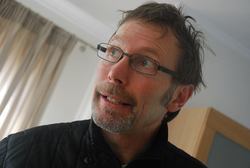Embodied attention - dharma practice - teachings and meditation

Jürgen is a dharma practitioner for more than 20 years. In 1992 after some in depth studies of contemporary and ancient philosophy he was drawn into the wake of “Buddhism”, in particular into Rinzai Zen (if of interest: lineage Sotetsu Yuzen Roshi, Seki Yuho Roshi, Hakuin Ekaku, Rinzai Gigen). His life at that point felt unhappy, shallow, and burdened. “Zen-Buddhism” seemed to have an answer on profound existential questions he was facing. A great doubt about how he experienced his conditioned reality was the spark and engine of taking up a rigorous practice while working at the same time in international automation industry. From 1992 to 1998 he got trained in Rinzai Zen, from 1998 to 2003 he became a practitioner of the Soto Zen school (i.of.i. lineage Roland Rech, Taisen Deshimaru Roshi, Kodo Sawaki, Dogen Kigen). His ongoing search let him encounter with Stephen Batchelor and his way of Vipassana teachings and practice in the beginning of the 2000’s. Participation in meditation retreats in France, Germany, Switzerland and The Netherlands followed. The way Stephen Batchelor presents the dharma and rethought it for a secular age* resonates fully with the experiences Jürgen has made on his path so far. Dharma practice is not tight at all to a certain context like monasteries or organized communities. Jürgen understands dharma practice as an inspiring path of individual and collective ethical thriving, as a culture of awakening bringing forth the emerald gem each one of us is carrying.
In essence Jürgen’s practice is based on the 4-fold tasks* in which the individual’s path can be experientially explored and creatively generated.
The 4-fold task:
The goal of the 4-fold task is to lead an integrated life.*
The path is to be cultivated:
Jürgen offers dharma teachings and practices in various ways conducive to establishing embodied attention*, to individual and organizational thriving and independently of religious preferences.
Glossary:
Dharma: Dharma has the Sanskrit root dhri, which means "that which upholds" or "that without which nothing can stand" or "that which maintains the stability and harmony of the universe." The practice of the dharma starts by paying embodied attention to what is going on.*
Embodied attention*: ... that such attention can be understood as attention that is born from one’s belly, attention that is nurturing, caring, and loving …
* Stephen Batchelor: after buddhism. Rethinking the dharma for a secular age. Yale University Press. 2015
In essence Jürgen’s practice is based on the 4-fold tasks* in which the individual’s path can be experientially explored and creatively generated.
The 4-fold task:
- Embrace life - [comprehending suffering].
- Let go of what arises - [letting go of reactivity].
- See its ceasing - [beholding its ceasing].
- Act! – [cultivating the path].
The goal of the 4-fold task is to lead an integrated life.*
The path is to be cultivated:
- complete view,
- complete thought, complete speech,
- complete action, complete livelihood, complete effort,
- complete mindfulness, complete concentration
- Link: http://secularbuddhism.org/2013/05/03/what-is-the-eightfold-path/
Jürgen offers dharma teachings and practices in various ways conducive to establishing embodied attention*, to individual and organizational thriving and independently of religious preferences.
- Weekly regular dharma and meditation practices
- Dharma practice and meditation practices in organizational contexts
- Full weekend or -week dharma and meditation practices
Glossary:
Dharma: Dharma has the Sanskrit root dhri, which means "that which upholds" or "that without which nothing can stand" or "that which maintains the stability and harmony of the universe." The practice of the dharma starts by paying embodied attention to what is going on.*
Embodied attention*: ... that such attention can be understood as attention that is born from one’s belly, attention that is nurturing, caring, and loving …
* Stephen Batchelor: after buddhism. Rethinking the dharma for a secular age. Yale University Press. 2015

